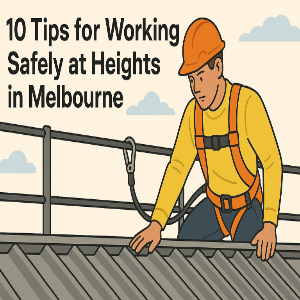Working at heights is one of the leading causes of serious injury and fatal incidents in Australia’s construction and maintenance industries. In Melbourne, where urban development, infrastructure upgrades, and maintenance of high-rise buildings are everyday realities, ensuring safe practices when working at heights is not just a legal requirement — it’s a moral responsibility.
Melbourne’s often unpredictable weather and dense urban landscapes present additional challenges that must be addressed through proactive safety measures. Whether you’re a seasoned professional, a safety officer, or a small business owner, these ten practical tips will help ensure your team remains safe, compliant, and confident while working above ground level.
1. Conduct a Thorough Risk Assessment
Before any task involving working at heights begins, a detailed risk assessment must be conducted. This should identify:
- Hazards specific to the site (slippery surfaces, overhead power lines, or fragile roofs).
- Environmental conditions such as wind gusts or rain.
- Access and egress challenges.
Risk assessments allow for the implementation of controls following the hierarchy of risk control — eliminating the risk where possible, substituting safer alternatives, or introducing engineering controls like guardrails.
In Melbourne’s Context:
With many sites located near busy roads, tram lines, or narrow laneways, consider the interaction between the height-related work and the public. Use barriers, signage, and spotters as needed.
2. Use the Right Personal Protective Equipment (PPE)
PPE is your last line of defense and should never be the sole safety strategy, but when required, it must be effective. At height, standard PPE includes:
- A certified full-body harness
- Shock-absorbing lanyards or self-retracting lifelines
- Helmets with chin straps
- Non-slip, steel-toe footwear
Local Note:
Victoria’s Occupational Health and Safety (OHS) regulations enforce strict PPE requirements. Ensure your equipment is AS/NZS 1891 compliant, regularly inspected, and replaced as necessary.
3. Implement Effective Fall Protection Systems
Fall protection systems can be either:
- Passive systems (e.g., guardrails, scaffolds, safety nets)
- Active systems (e.g., fall arrest systems where workers wear harnesses attached to anchor points)
Always prioritize passive protection over active systems because they don’t rely on human behavior. When you do use active systems, ensure:
- Anchor points are secure and appropriately rated
- Fall distances are calculated to avoid impact
- Workers are trained in rescue procedures
Melbourne’s tall office towers and apartment complexes often involve rope access or swing-stage scaffolds. Engage engineers for system design and verification.
4. Provide Accredited Training and Competency Verification
No one should work at height without proper training. In Victoria, the WorkSafe authority mandates that employers verify their workers’ competency through certified training programs, such as:
- Work safely at heights (RIIWHS204E or equivalent)
- Elevated Work Platform (EWP) operation
- High-risk work licenses (for scaffolding, rigging)
Training should not be a one-time event. Schedule regular refresher sessions and toolbox talks that address site-specific hazards.
5. Monitor and Mitigate Weather Hazards
Melbourne is famous for its “four seasons in a day” weather. Strong winds, rain, or extreme heat can compromise safety at heights. Wind gusts in particular are dangerous on scaffolds, ladders, and elevated platforms.
Best Practices:
- Use weather apps with live wind speed tracking.
- Halt operations when wind speeds exceed safe limits (often 28–40 km/h, depending on equipment).
- Ensure surfaces are dry and non-slippery before work resumes.
6. Use Proper Access Equipment and Inspect it Regularly
Scaffolding, ladders, mobile towers, and elevated work platforms (EWPs) are common tools on Melbourne worksites. Always:
- Ensure equipment is suitable for the task.
- Avoid makeshift structures.
- Inspect equipment daily for damage, loose connections, or instability.
Local Standards:
Scaffolds in Victoria must be erected and modified only by licensed scaffolders. EWP operators must be licensed under national HRW (high-risk work) laws if using boom lifts over 11 meters.
7. Plan and Limit Time Spent at Height
The more time spent above ground, the higher the risk. Efficient planning reduces exposure. This includes:
- Prefabricating components at ground level, where possible
- Using mechanical lifting for tools and materials
- Assigning roles clearly to avoid unnecessary personnel at height
For example, plan roof installation or signage maintenance around quiet site hours, and stagger tasks to reduce congestion at height.
8. Establish and Practice Emergency Rescue Plans
Having fall protection is crucial, but what happens if a fall arrest system is engaged? Hanging in a harness for too long can cause suspension trauma.
Every Melbourne worksite where height work occurs must have a rescue plan that includes:
- On-site rescue equipment (e.g., rescue kits, ropes)
- Trained responders
- Clear communication channels
Don’t rely on external emergency services as your primary response — minutes count in harness suspension scenarios.
9. Foster a Safety Culture
Even the best safety systems fail if workers ignore protocols or feel pressured to cut corners. Build a culture where safety is everyone’s responsibility:
- Conduct daily pre-start meetings that include height safety discussions.
- Empower workers to stop unsafe work without fear of reprisal.
- Encourage reporting of near misses and hazards.
Companies that invest in culture, with supportive leadership and open communication, consistently outperform those that rely solely on compliance.
10. Stay Compliant with Victorian Laws and Regulations
WorkSafe Victoria is the governing body for workplace safety in Melbourne and enforces the Occupational Health and Safety Act 2004 and associated regulations. Non-compliance can lead to hefty fines, legal action, or even criminal prosecution in severe cases.
Regularly review:
- Codes of Practice for Fall Prevention
- Australian Standards (e.g., AS/NZS 1891, AS/NZS 1576 for scaffolding)
- Industry-specific safety alerts
Stay up to date via WorkSafe bulletins, industry associations like Master Builders Victoria, and safety consultants.
Conclusion: Prevention is Better Than Reaction
Melbourne’s skyline will continue to grow, and the need for safe, skilled work at height will only increase. By embracing a proactive, systems-based approach to safety — starting with comprehensive planning and training and ending with compliance and culture — your workplace can minimize incidents and maximize confidence.
Working at heights doesn’t need to be dangerous if it’s done correctly. With these 10 essential safety tips, you can keep your workers secure, your projects on track, and your legal obligations met.



